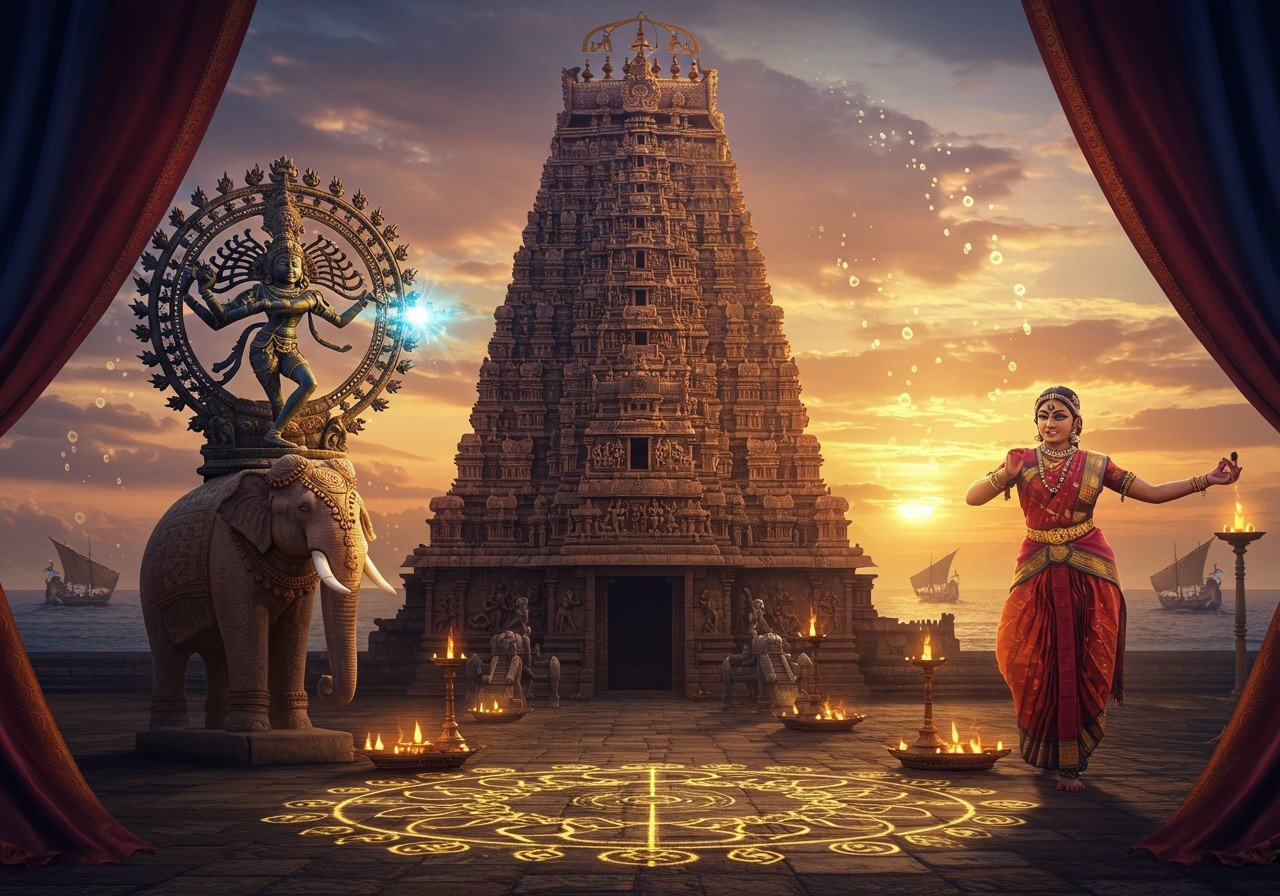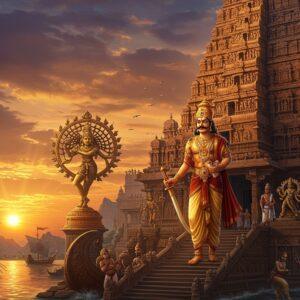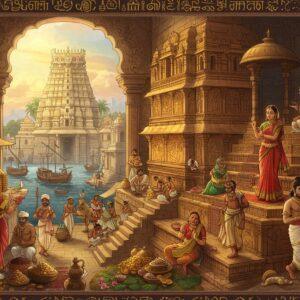
South India, a land of vibrant traditions, diverse languages, and rich history, has profoundly shaped India’s cultural and historical landscape. This article delves into the key dynasties, cultural milestones, and historical interpretations that define South India, offering a captivating exploration for those intrigued by its heritage.
Ancient South India: Empires and Innovations
Ancient South India witnessed the rise of remarkable civilizations. The Sangam period (3rd century BCE to 3rd century CE) stands out for its rich literature and extensive trade networks. The Chera, Chola, and Pandya dynasties played pivotal roles in shaping the political dynamics of the region. Archaeological discoveries, such as the Keeladi excavations, provide valuable insights into ancient urban life and cultural practices.
This era saw the influence of Jainism and Buddhism, alongside thriving trade connections with Roman and Southeast Asian empires. The development of Dravidian languages and early scripts marked significant cultural advancements. Ancient ports like Muziris and Arikamedu served as crucial hubs for international trade, connecting South India to the world.
Medieval South India: Architectural Wonders and Devotion
Medieval South India witnessed the rise of powerful dynasties, including the Cholas (c. 300 – 1279 CE), Chalukyas (6th-12th century), and Pallavas (4th-9th century). This period is renowned for architectural marvels like the magnificent Brihadeshwara Temple in Thanjavur, built by the Cholas around 1010 CE and the intricate rock-cut temples of Mahabalipuram, showcasing the Pallava’s artistic prowess. The Bhakti movement, a period of intense religious devotion, flourished, deeply impacting literature and temple culture.
The Cholas’ maritime dominance was remarkable, with expeditions reaching Southeast Asia. Their well-organized administration and societal structure contributed to a period of stability and prosperity. The contributions of rulers like Rajaraja Chola I (reigned 985-1014 CE) and Krishna Deva Raya of the Vijayanagara Empire (reigned 1509–1529 CE) were instrumental in shaping the political and cultural landscape.
The Hoysala Empire (c. 1000-1346) left its unique mark through the intricate Vesara style of architecture, evident in temples like the Chennakesava Temple at Belur.
Late Medieval to Early Modern Period: Empires and European Influence
The Vijayanagara Empire (1336-1646) made significant contributions to art, architecture, and administration. Interactions with the Deccan Sultanates played a crucial role in shaping the political landscape of South Indian kingdoms. The arrival of European traders, starting with the Portuguese in the late 15th century, led to the establishment of colonial footholds by the Portuguese, Dutch, and eventually the British.
This period witnessed significant socio-economic changes. Battles like the Battle of Talikota in 1565, which marked the decline of the Vijayanagara Empire, had far-reaching consequences. Figures like Tipu Sultan (1750 – 1799) of Mysore fiercely resisted British expansion.
Colonial Period: British Rule and the Freedom Struggle
British supremacy in South India led to the integration of the region into the British Raj. British policies significantly impacted agriculture, industry, and society. The introduction of new crops like tea and coffee and the construction of railways and roads transformed the local economy.
South India played a vital role in the Indian independence movement. Leaders like Subramania Bharati (1882-1921), a renowned Tamil poet, and C. Rajagopalachari (1878-1972), the last Governor-General of India, were instrumental in the struggle for freedom. Women like Velu Nachiyar (1730–1796), queen of the Sivaganga estate, actively resisted British rule.
Post-Independence Era: Shaping Modern South India
After India’s independence in 1947, South Indian states were reorganized based on linguistic identities, leading to the formation of Tamil Nadu, Karnataka, Andhra Pradesh, Telangana, and Kerala.
Each state developed its unique political and economic trajectory. Tamil Nadu became a center of political activism, while Karnataka emerged as a hub for technology and industry. Andhra Pradesh and Telangana focused on regional development, and Kerala achieved remarkable progress in education and healthcare.
Cultural Contributions: A Tapestry of Traditions
South India’s cultural heritage is rich and diverse. Classical dance forms like Bharatanatyam, Kuchipudi, and Kathakali, along with Carnatic music, are celebrated worldwide. The architectural splendor of South Indian temples, particularly in Tamil Nadu, Karnataka, and the Hoysala region, showcases intricate craftsmanship and historical significance.
South Indian literature, with languages like Tamil, Telugu, Kannada, and Malayalam, boasts a rich literary tradition. Cuisine, with dishes like dosa, idli, and sambar, is globally popular. Festivals like Pongal, Onam, and Ugadi celebrate the region’s diverse traditions.
South Indian cinema has made significant contributions to the Indian and global film industries. Iconic actors like Rajinikanth and Mohanlal enjoy immense popularity.
Poojn.in: Your Companion on a Cultural Journey
For those seeking to connect with South India’s rich spiritual traditions, Poojn.in, India’s leading online store for cultural goods and services, offers a wide selection of authentic puja items. Whether you are looking for traditional brass lamps (vilakku), pure kumkum, or specific items for deities like Lord Murugan (also known as Kartikeya), Poojn.in provides high-quality products to support your spiritual practices.
Explore our collection of puja items specifically curated for South Indian traditions and rituals, including:
- Brass and copper items for abhishekam, an important ritual bath for deities. These items are crafted according to traditional methods, ensuring authenticity and purity.
- Incense sticks and other aromatic substances used in South Indian temples and homes, creating a sacred atmosphere during prayers and rituals.
- Special puja items for Murugan worship, including vel (spear) replicas, reflecting the deity’s significance in South Indian culture. These items are ideal for personal altars or as offerings during temple visits.
- A range of sindoor containers and other traditional items essential for various South Indian rituals and ceremonies, providing a convenient way to access these culturally significant products.
Conclusion
South India’s history is a vibrant tapestry woven with rich traditions, pivotal events, and influential figures. From ancient empires to the struggle for independence and the challenges of modern nationhood, the region has played a crucial role in shaping India’s destiny. Its cultural contributions, from classical arts to contemporary cinema, continue to enrich the world. South India’s journey is a testament to its resilience, progress, and unwavering spirit, a story that continues to unfold with each passing generation.
Further explore the rich tapestry of South Indian culture and heritage through our articles on:
- South Indian Temple Architecture: Delve deeper into the magnificent architectural styles that grace the South Indian landscape.
- Kurmanathaswamy Temple Festivals: Discover the vibrant festivals and rituals associated with this important temple.
- A Pilgrim’s Guide to Kurmanathaswamy Temple: Plan your visit to this sacred site with our comprehensive guide.
- South Indian Lakshmi Narasimha Temples: Embark on a spiritual journey to these powerful temples dedicated to Lord Narasimha.


